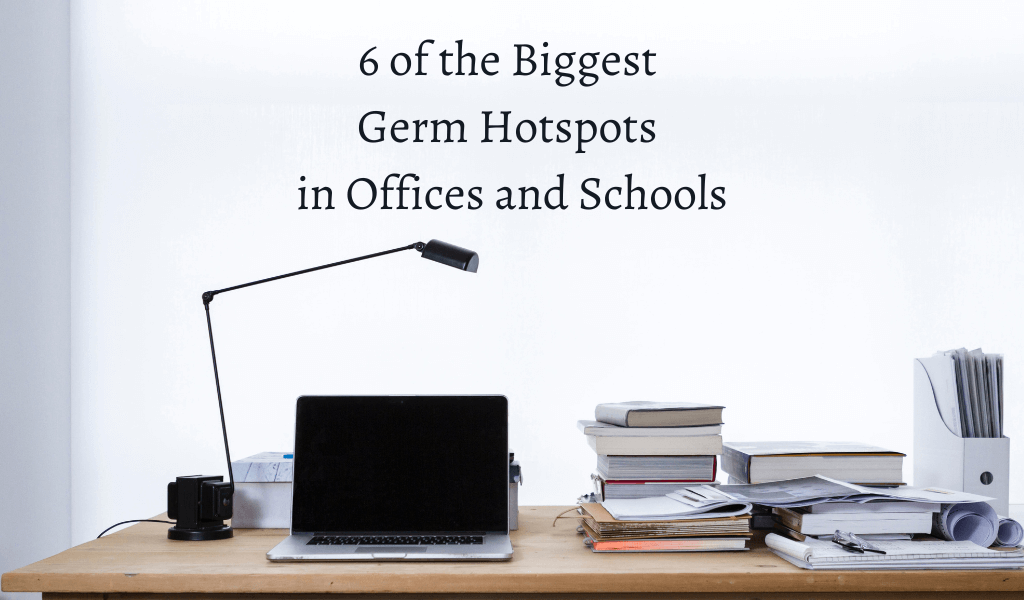Are these six germ hotspots on your commercial cleaning checklist? Here’s why they should be.
Walk into any office or school, and you’ll find some areas that are downright gross. Spills in the microwave that no one cleaned or that spot of moldy drywall from an old leak are teeming with bacteria. But some of the biggest germ hotspots are invisible. They look like your average section of counter space or light switch.
Under the scrutiny of microscopic vision, these innocuous-seeming spots host thriving colonies of bacteria and viruses. Unfortunately, many of these germs are just waiting for someone to unknowingly pick them up, where they’ll go on to cause colds, flu, and other irritations.
Little do these germs know that commercial cleaning experts are headed their way with a roadmap to their homes. Soon, cleaning solutions and disinfectants will literally wipe out these germ hotspots, so office workers, teachers, and students can go about their day without the worry of picking up an infection.
If you are ready to take your cleaning organization to the next level, take advantage of a free call with Janitorial Manager to see how our software can make your janitorial operation more successful.
These germ hotspots don’t stand a chance against your disinfection powers
Some of these germ hotspots won’t be much of a surprise, especially given the Covid cleaning protocols so many facilities have adopted. There may be a few surprises on this list, though. And it’s never a bad idea to review.
1. Door Knobs, Light Switches, and Other “High Touch” Areas. It’s likely you already know most of these germ hotspots, but a reminder is always good. There are so many people every day who will touch door knobs when they enter or leave a room. Elevator buttons are another giant hotspot. Basically, any place that might get a lot of contact from numerous people.
2. Food Prep Areas. Most people don’t realize the extent to which food prep areas are germ hotspots. This is because there are so many possible routes of contamination, from droplets of infected moisture from meats to eggshells to crumbs from sandwiches. In theory, food service workers in school or office kitchens will take care of most disinfection when they clean during or after a shift. Where you really need to take care, however, is in spaces like break rooms or cafeteria tables. As just one example, E. coli can live on surfaces for at least a few hours and possibly up to a few days.
3. Telephones. This one may be obvious, especially if we’re talking about phones that multiple people may use. It doesn’t take much imagination to understand why there would be plenty of germs hanging on the telephone.
4. Sponges. Many offices have a small kitchen area for employees. Chances are, those kitchens have a sponge for washing coffee mugs and other utensils. How often does that sponge get changed? Probably not often enough. Sensationalist headlines will pop up every now and then about how many germs live on your kitchen sponge. As click-baity as they may be, they aren’t wrong. Sponges are downright disgusting. If it’s part of your contract, bring in a fresh sponge at least once each week. If it’s not? You may want to encourage the facility manager to replace it.
5. Desktops, Computer Keyboards, and Mice. These spots might not be a surprise. People eat at their desks; their hands are all over keyboards and the computer mouse. And some of these people don’t wash their hands nearly as often as they should.
6. The Air. The air around us might not seem like other germ hotspots. You can’t exactly disinfect the air, anyway. But if we’ve learned one thing from all the research on Covid, it’s that viruses, fungi, bacteria, dust, and other contaminants can linger in the air for quite some time. While you can’t go around spraying cleaning solutions into the HVAC systems all day, there are some things you can do. We know that good ventilation is one of the keys to keeping the air clean. Barring any extenuating circumstances like smoke from wildfires or pollution, try to get some fresh air into the building if you can. Open windows and run fans while you’re working, and encourage facility operators to do the same. Obviously, that won’t always be possible for safety or other reasons. However, a little fresh air goes a long way.
The fact is, there are germ hotspots pretty much anywhere there are people. But the responsibility to keep people healthy isn’t just on you- it’s on everyone. Whether you’re a building service contractor or in house provider, communicate your knowledge. Share with them the steps they can customers steps they can take to ensure the health and wellbeing of themselves and others, including hand washing, using sanitizing wipes on phones, and taking extra care in food prep areas.
Harness the value of Janitorial Manager to advance your cleaning organization like never before. Learn more today with a free discovery call and find out how to make your cleaning business more efficient and cost-effective!

